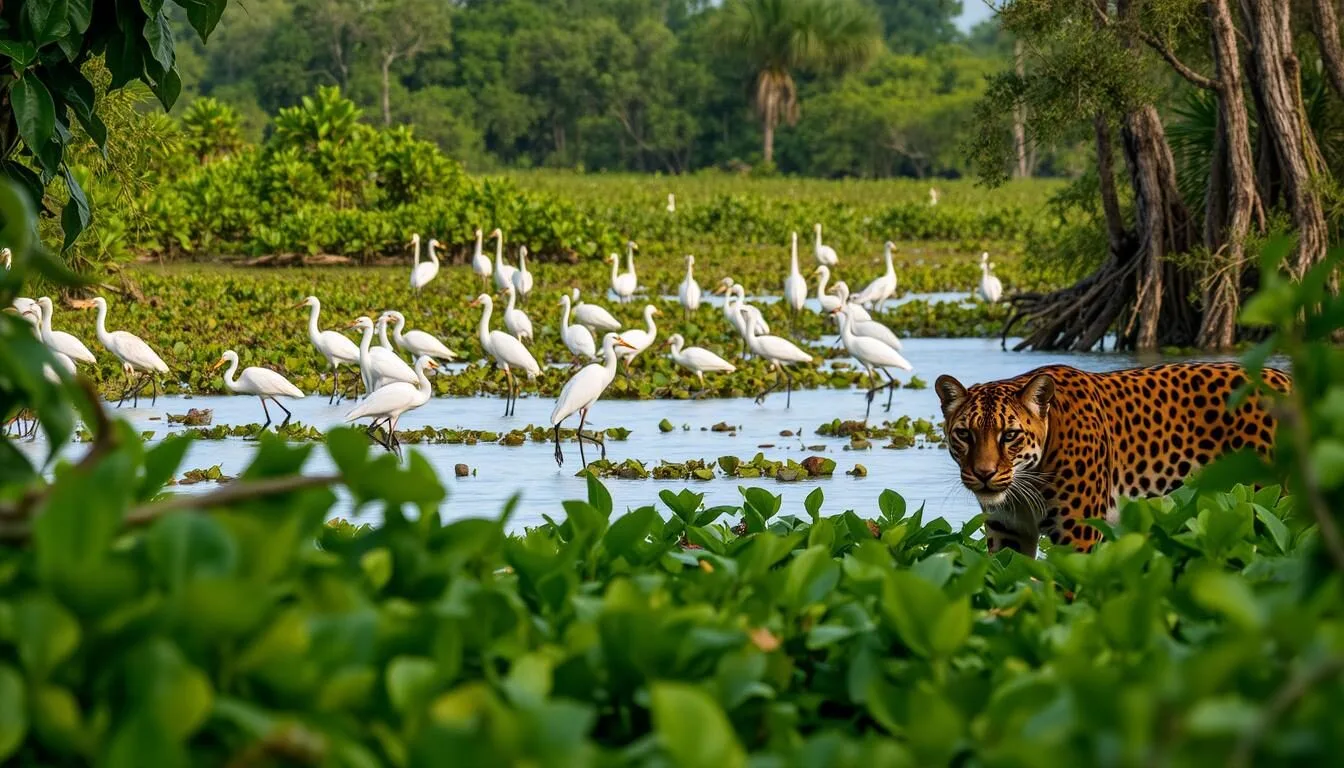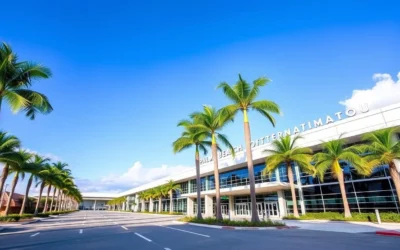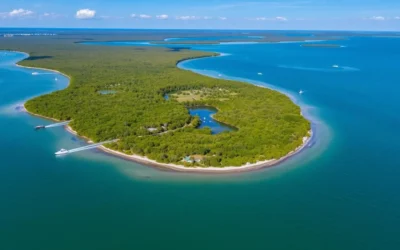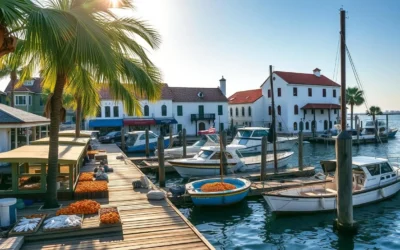✓ Accommodations ✓ Flights ✓ Rental Cars ✓ Tours & Activities
Spanning 1.5 million acres in southern Florida, this vast and diverse landscape is home to an incredible array of wildlife, including manatees, American crocodiles, and numerous bird species.
As the third-largest national park in the lower 48 states, it offers a wide range of activities and breathtaking scenery, from sawgrass marshes to mangrove forests.
Whether you’re planning a day trip or a multi-day adventure, you’ll find countless opportunities for adventure, from hiking and kayaking to airboat tours and ranger-led programs, making it an unforgettable experience.
Discovering the Unique Ecosystem of the Everglades
As you step into the Everglades National Park, you’re about to experience one of the most unique ecosystems in the world. The Everglades is an enormous wetland that is fed by water from Lake Okeechobee, creating a diverse and complex environment that supports a wide range of plant and animal life.
The River of Grass: Understanding the Everglades Landscape
The Everglades ecosystem is often called the “River of Grass” because it’s essentially a very wide, shallow river flowing slowly from Lake Okeechobee southward to Florida Bay. This unique landscape features diverse habitats, including sawgrass marshes, cypress swamps, hardwood hammocks, and mangrove forests, each supporting different plant and animal communities. The Everglades has faced significant environmental challenges, including water diversion projects that dramatically altered natural water flow patterns.
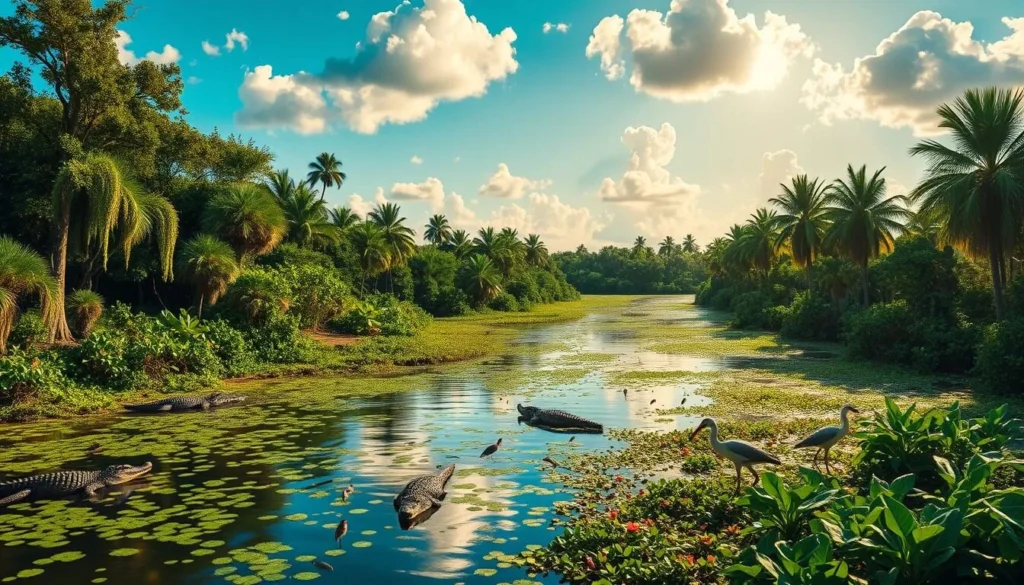
Wildlife You Can Expect to See
The Everglades is home to a vast array of wildlife, including American alligators, American crocodiles, manatees, over 360 bird species, and even the elusive Florida panther. Conservation efforts are ongoing to restore natural water flow and protect endangered species, making the Everglades both a natural wonder and an important case study in environmental restoration. As you explore the Everglades, you’ll have the opportunity to see these incredible creatures up close.
Planning Your Visit to Everglades National Park
Before you head to the Everglades, understanding the best times to visit and how to navigate the park is crucial. This knowledge will help you make the most of your trip and enjoy the park’s vast wilderness.
Best Time to Visit the Everglades
The best time to visit Everglades National Park is during the dry season, from December to April. During this period, temperatures are mild, humidity is lower, and mosquito activity is minimal. Visiting during the wet season, from May to November, means hot and humid conditions with afternoon thunderstorms and higher mosquito populations.
How Many Days to Spend in the Park
For a comprehensive experience, plan to spend at least 2-3 days in the park. This allows you to explore different regions, as the park’s three main entrances are not connected internally. With one day, you can visit one section and enjoy short trails and wildlife viewing.
Entrance Fees and Permits
Entrance fees are $30 per vehicle (valid for 7 days), $25 per motorcycle, or $15 per pedestrian/cyclist. The America the Beautiful Pass ($80) provides year-round access to all national parks. It’s also important to check the park’s website for current conditions, as certain areas may be closed due to weather or maintenance.
| Category | Fee | Validity |
|---|---|---|
| Vehicle | $30 | 7 days |
| Motorcycle | $25 | 7 days |
| Pedestrian/Cyclist | $15 | 7 days |
| America the Beautiful Pass | $80 | Year-round |

The Three Main Entrances to Everglades National Park
Everglades National Park is accessible through three main entrances, each offering a unique experience. Understanding these entrances is key to planning your visit.
Homestead Entrance (Ernest F. Coe Visitor Center)
The Homestead Entrance, featuring the Ernest F. Coe Visitor Center, is the most popular gateway. It provides access to the Royal Palm and Flamingo areas, with numerous trails and wildlife viewing opportunities. You can explore the park’s diverse ecosystems and get valuable information at the visitor center.
Shark Valley Entrance
Located west of Miami, the Shark Valley Entrance is renowned for excellent alligator viewing. Take a tour by tram or bicycle along the 15-mile paved loop trail and enjoy the observation tower.
Gulf Coast Entrance (Everglades City)
The Gulf Coast Entrance near Everglades City offers access to the Ten Thousand Islands region. It’s ideal for kayaking, canoeing, and boat tours through mangrove forests. Note that this area is under construction until Fall 2025.
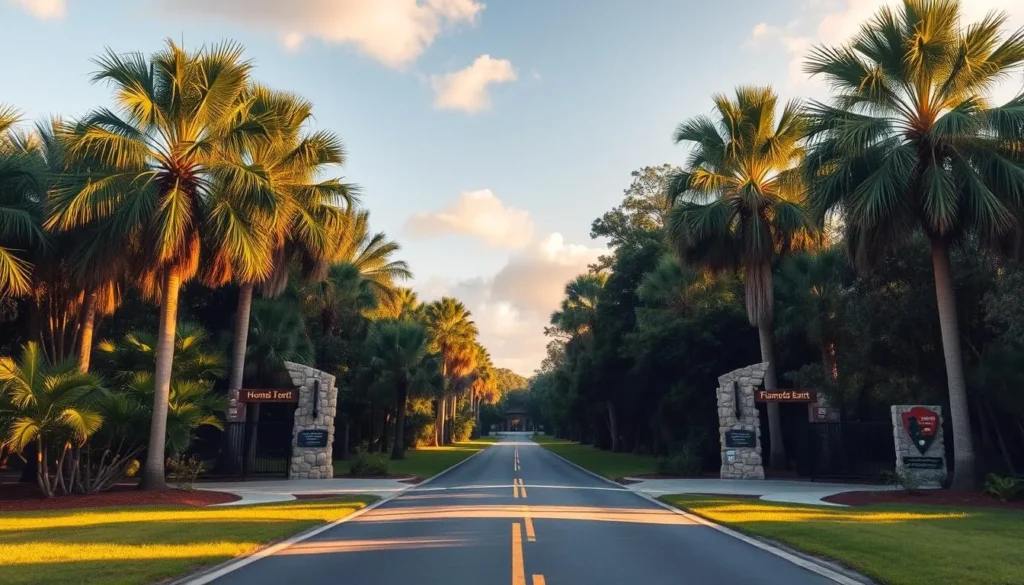
Exploring the Royal Palm Area
Located near the Homestead entrance, the Royal Palm area is renowned for its excellent wildlife viewing opportunities. This area is a must-visit for anyone looking to experience the diverse ecosystem of the Everglades National Park.
Ernest F. Coe Visitor Center
Start your visit at the Ernest F. Coe Visitor Center to get oriented with informative exhibits and park maps. Rangers are available to provide advice on current trail conditions and wildlife sightings, ensuring you’re well-prepared for your adventure.
Anhinga Trail: Prime Wildlife Viewing
The Anhinga Trail is a 0.8-mile paved and boardwalk loop, considered the premier wildlife viewing location in the park. Here, you can spot alligators, turtles, and numerous bird species, including the namesake Anhinga.
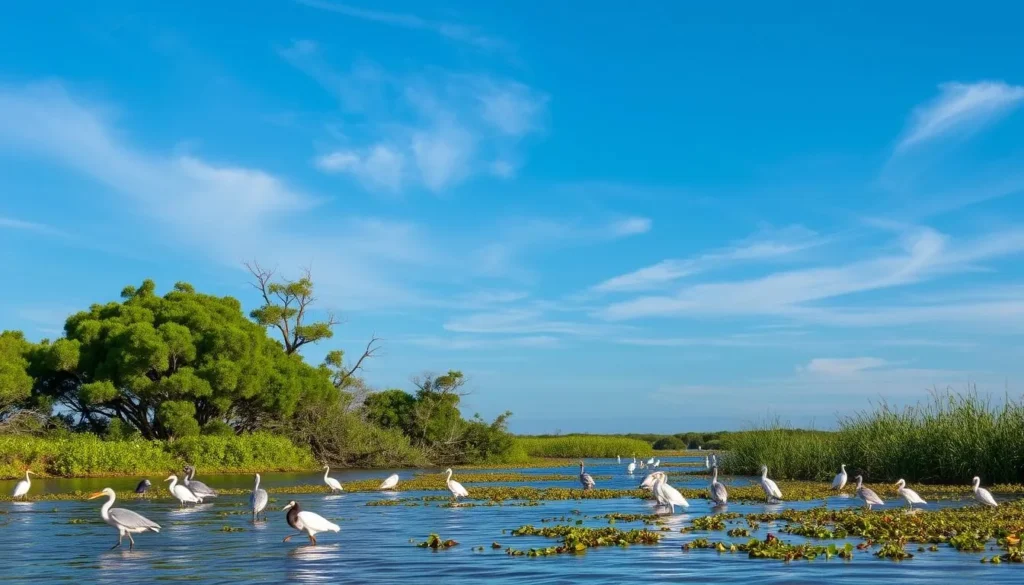
Gumbo Limbo Trail
For a shaded experience, visit the Gumbo Limbo Trail, which takes you through a hardwood hammock featuring distinctive reddish-barked gumbo limbo trees. This trail provides a nice contrast to the open wetlands.
Nike Missile Site
Don’t miss the historic Nike Missile Site, a Cold War relic open on Saturdays from 10 AM to 2 PM. This site offers a unique glimpse into the park’s military history.
Visiting the Royal Palm area during early morning or late afternoon typically offers the best wildlife viewing experiences when animals are most active.
Must-Do Activities in the Flamingo Area
The Flamingo area is a must-visit destination within Everglades National Park, offering a unique blend of wildlife viewing and outdoor adventures.
Guy Bradley Visitor Center
Start your journey at the Guy Bradley Visitor Center, formerly known as the Flamingo Visitor Center, where you can gather information about boat tours and canoe/kayak rentals. The center provides valuable insights into the best spots for wildlife viewing in the area.
Mahogany Hammock Trail
Explore the Mahogany Hammock Trail, a boardwalk that winds through a dense, jungle-like hardwood hammock featuring some of the oldest and largest mahogany trees in the United States. This trail offers a unique hiking experience amidst a lush, tropical environment.
Coastal Prairie Trail
For a more extended hiking experience, embark on the Coastal Prairie Trail, a 7.5-mile round-trip journey through open grasslands to the shores of Florida Bay. This trail provides an opportunity to witness the diverse wildlife and ecosystems of the Everglades.
Spotting Manatees and Crocodiles
The Flamingo area is renowned for its wildlife viewing opportunities, particularly for spotting manatees and crocodiles. Visit the marina and canal areas, especially during winter months, to catch a glimpse of these incredible creatures in their natural habitat.

Scenic Stops Along Main Park Road
As you drive through Everglades National Park, you’ll encounter several scenic stops that showcase the diverse ecosystems within the park. The 38-mile Main Park Road connecting the Royal Palm and Flamingo areas features these stops, providing a glimpse into the park’s unique landscapes.
Pa-Hay-Okee Overlook
The Pa-Hay-Okee Overlook offers a rare elevated view of the vast “River of Grass” and Shark River Slough. This stop provides one of the best panoramic vistas in the predominantly flat park, giving you a chance to appreciate the Everglades’ vastness.
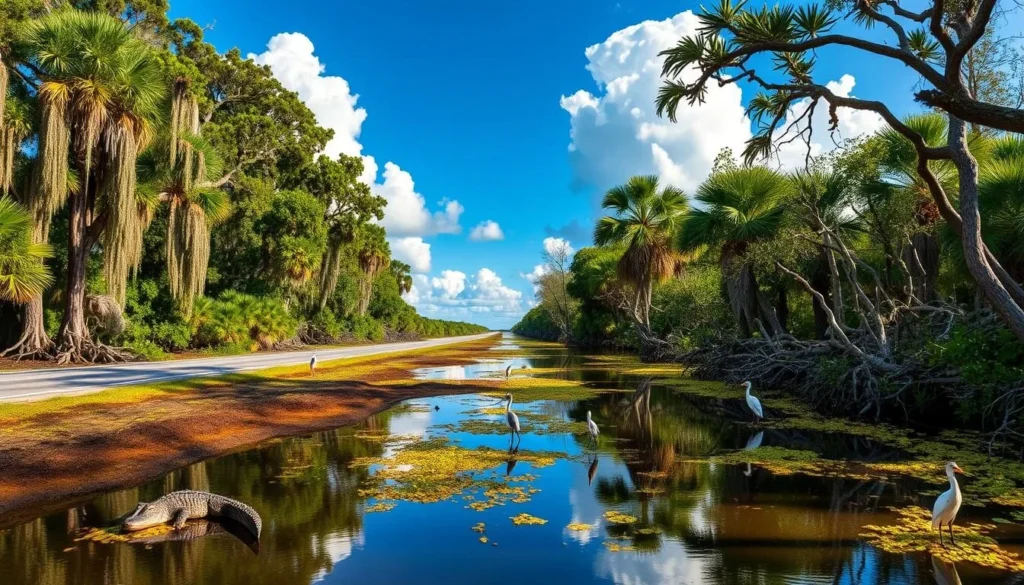
Pinelands Trail
The short 0.4-mile Pinelands Trail loop takes you through a subtropical pine forest growing on limestone outcroppings. This trail represents one of the most diverse plant communities in the park, offering a unique opportunity to explore the Everglades’ varied ecosystems.
West Lake Trail
West Lake Trail features a 0.5-mile boardwalk through a mangrove forest and along the shores of West Lake. This stop provides insight into the critical coastal ecosystem, allowing you to observe the diverse wildlife that inhabits this unique environment.
These scenic stops along the Main Park Road are quick and easy to explore, each requiring only 15-30 minutes. They offer a great way to break up the drive between Royal Palm and Flamingo while experiencing the remarkable diversity of Everglades habitats.
Shark Valley: Best Spot for Alligator Sightings
Shark Valley, situated in the Everglades, is renowned for its incredible alligator sightings and diverse wildlife. This area is a must-visit for anyone looking to experience the natural beauty of Everglades National Park.
Shark Valley Tram Tour
The Shark Valley Tram Tour is a 2-hour guided experience that takes you through a 15-mile paved loop trail. You’ll have the opportunity to see alligators, turtles, and various bird species with a knowledgeable naturalist. It’s advisable to book your tickets in advance as tours frequently sell out.
Shark Valley Observation Tower
At the halfway point of the loop stands the 65-foot Shark Valley Observation Tower, offering panoramic views of the vast “River of Grass” and often dozens of alligators in the waters below. This is a prime spot for wildlife viewing and photography.
Visiting Shark Valley early in the morning can provide the best wildlife viewing opportunities, especially during the dry season. The Shark Valley Visitor Center is the starting point for your adventure, offering exhibits and information on the area.
Everglades National Park, Florida: Best Things to Do – Top Picks for Water Activities
To truly experience the Everglades, you need to get on the water. Water activities provide some of the most immersive and memorable experiences in Everglades National Park, allowing you to explore areas inaccessible by land.
Kayaking and Canoeing Adventures
Kayaking and canoeing are popular ways to experience the park’s waterways, with rentals available at the Flamingo Marina and Gulf Coast areas. You can paddle through the calm waters and get up close to the diverse wildlife.
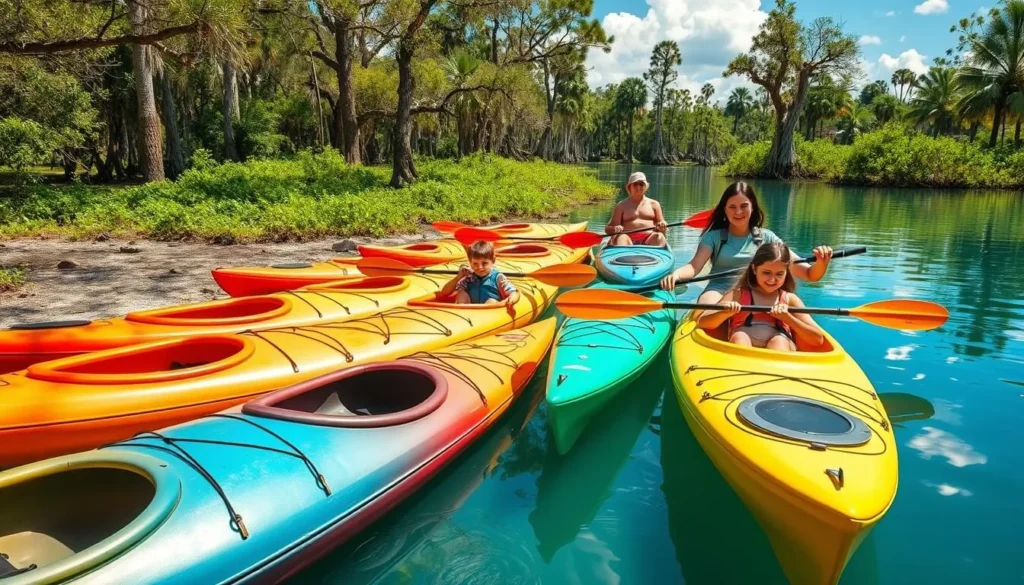
Nine Mile Pond Canoe Trail
The Nine Mile Pond Canoe Trail offers a marked 5.5-mile loop through diverse landscapes, including open water, mangrove tunnels, and sawgrass prairies. This trail is perfect for intermediate paddlers looking for a challenging and rewarding experience.
Boat Tours in the Ten Thousand Islands
Boat tours in the Ten Thousand Islands region provide access to the maze-like mangrove islands and channels of the western Everglades. You can spot dolphins, manatees, and numerous bird species on these guided tours.
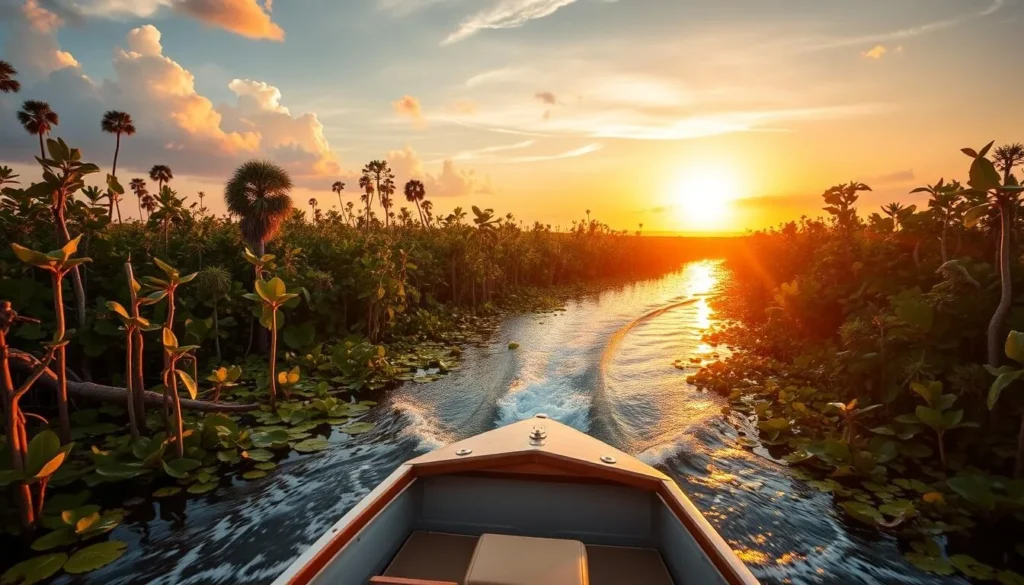
Guided boat tours from Flamingo Marina take you through Buttonwood Canal, Coot Bay, and Whitewater Bay, where naturalist guides help identify wildlife and explain the ecosystem. Park rangers often recommend water activities as the best way to truly experience the Everglades.
Thrilling Airboat Tours Through the Marshes
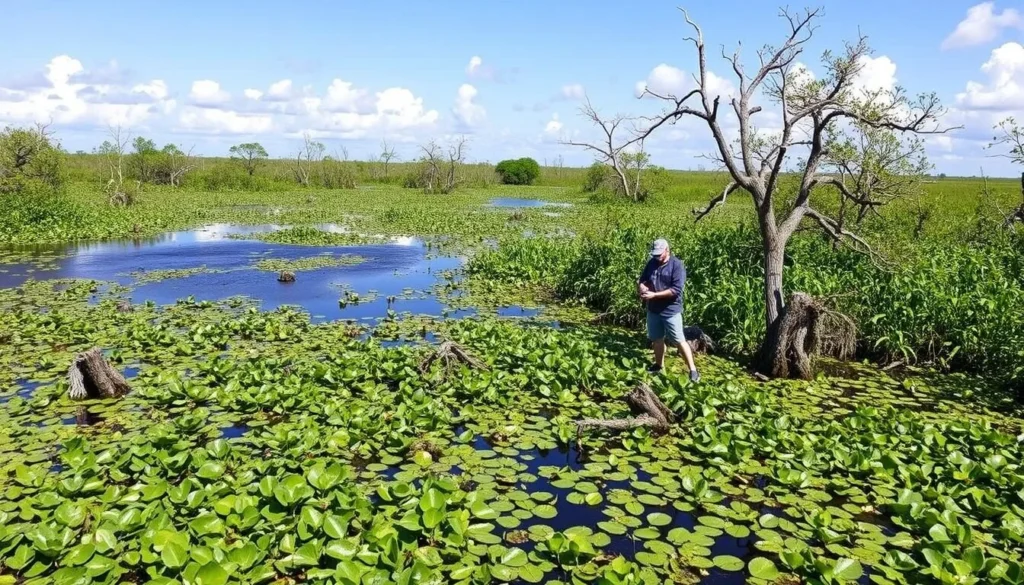
Airboat tours offer a thrilling way to explore the Everglades’ vast and diverse ecosystem. These tours allow you to glide across shallow marshes at high speeds, providing an exhilarating experience amidst the unique landscape of the Everglades National Park.
What to Expect on an Airboat Ride
During an airboat ride, you can expect a mix of fast-paced excitement through open water areas and slower wildlife viewing opportunities. The tours typically last between 40 to 60 minutes and include narration from experienced guides who explain the ecosystem and highlight wildlife that might otherwise go unnoticed.
Key Highlights of an Airboat Tour:
- Glide across shallow marshes at high speeds
- Opportunities to spot alligators, birds, and other wildlife
- Guided narration explaining the Everglades ecosystem
- Duration: Typically 40-60 minutes
Recommended Airboat Tour Companies
The National Park Service authorizes three companies to operate airboat tours in the northeastern section of Everglades National Park: Coopertown Airboat Tours, Gator Park, and Everglades Safari Park. These companies provide a safe and informative experience, ensuring that you get the most out of your visit.
Why Choose These Companies?
- Authorized by the National Park Service
- Experienced guides providing insightful narration
- Safety and customer satisfaction prioritized
Best Hiking Trails in the Everglades
The Everglades National Park offers a diverse range of hiking trails that cater to different preferences and abilities. With 24 trails to choose from, you can explore the park’s unique ecosystems and spot a variety of wildlife.
Short and Family-Friendly Trails
For families or those looking for a quick hike, trails like the Anhinga Trail (0.8 miles) and Mahogany Hammock Trail (0.5 miles) are ideal. These trails feature boardwalks that keep you dry while offering intimate views of the wetlands and hammocks.
Longer Hikes for the Adventurous
If you’re looking for a longer hike, the Coastal Prairie Trail (7.5 miles round-trip) and Snake Bight Trail (3.2 miles round-trip) offer exciting journeys through less-visited areas of the national park.
Accessible Trails and Boardwalks
Many trails in the Everglades are accessible, featuring boardwalks that provide barrier-free access to scenic areas. Trails like Anhinga, Mahogany Hammock, and Pa-hay-okee Overlook are perfect for those with mobility issues.
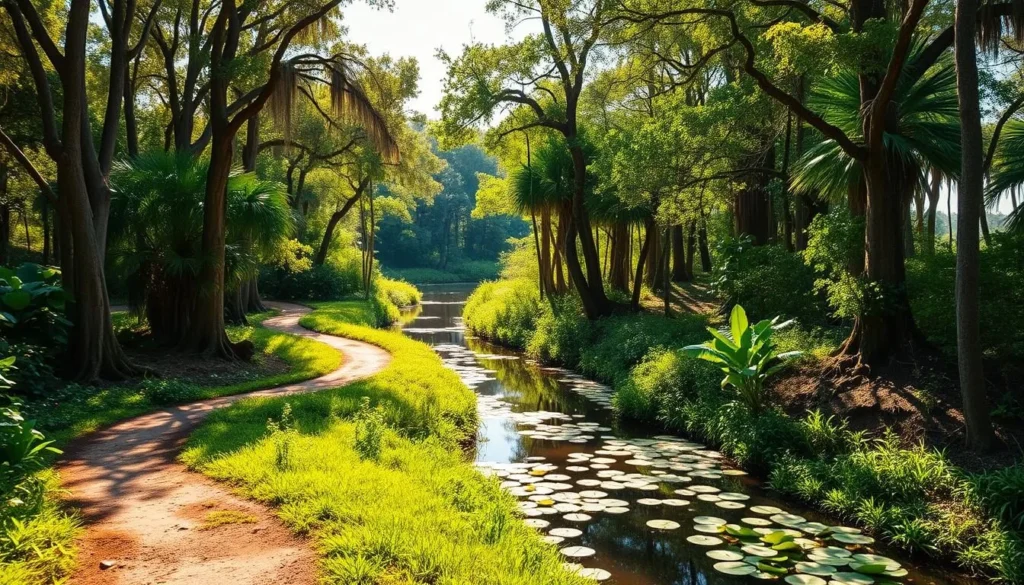
Wildlife Viewing Opportunities
The Everglades National Park is a haven for wildlife enthusiasts, offering a unique chance to observe a diverse range of species in their natural habitats. With its vast wetlands and varied ecosystems, the park is home to numerous animals, including alligators, crocodiles, manatees, dolphins, and over 360 bird species.
Best Spots to See Alligators
Shark Valley is widely regarded as the premier location for alligator sightings, particularly during the dry season from December to April. The Anhinga Trail in the Royal Palm area is another excellent spot, offering elevated boardwalks for optimal viewing.
Bird Watching in the Everglades
The Everglades is a birdwatcher’s paradise, with prime viewing locations including Eco Pond near Flamingo, Anhinga Trail, and Paurotis Pond. These areas attract a wide variety of bird species, including roseate spoonbills and wood storks.
Photography Tips for Wildlife
To capture stunning wildlife photos, bring a telephoto lens (at least 200mm), visit during early morning or late afternoon for optimal lighting, and practice patience while maintaining a safe distance from animals.
- Wildlife viewing is the primary attraction in Everglades National Park.
- Shark Valley is the best spot for alligator sightings.
- The Anhinga Trail offers excellent wildlife viewing from elevated boardwalks.
Ranger-Led Programs and Tours
Discover the wonders of Everglades National Park through its diverse range of ranger-led programs and tours, suitable for various interests and ages. These activities offer a unique opportunity to explore the park’s ecosystems with expert guidance.
Guided Walks and Talks
Ranger-led programs offer some of the most educational and memorable experiences in the park, with many available free of charge. Guided walks and talks provide expert interpretation of the park’s ecosystems, wildlife, and conservation challenges at all three visitor centers throughout the day.
Slough Slogging Adventures
Shark Valley is a popular spot for Slough Slogging Adventures, where you can wade through the “River of Grass” with a ranger. This immersive experience allows you to explore the wetland ecosystem up close, spotting unique features like the limestone base and carnivorous plants.
Night Hikes and Star Gazing
Night hikes and stargazing programs reveal a different side of the Everglades, with opportunities to spot nocturnal wildlife and enjoy the dark skies. These guided tours provide a unique experience that complements your daytime explorations.
Camping in the Everglades
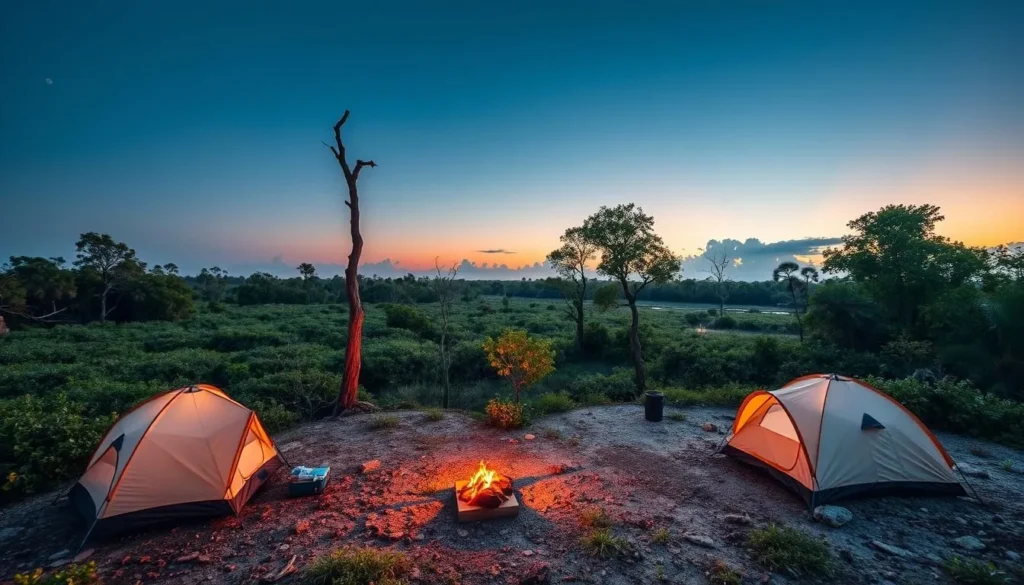
Camping in Everglades National Park offers an unparalleled opportunity to immerse yourself in the vast, untouched beauty of one of America’s most unique ecosystems. With several camping options available, you can choose the experience that best suits your preferences.
Flamingo Campground
Flamingo Campground, located at the southern end of the park, is a popular choice among visitors. It offers both tent and RV sites, along with amenities such as restrooms, showers, and a nearby marina. This campground is open year-round, making it an ideal spot for those planning to visit during any season.
Long Pine Key Campground
For a more rustic experience, Long Pine Key Campground is situated near the Homestead entrance, providing a peaceful retreat surrounded by a beautiful pine rockland habitat. It’s perfect for those seeking shade and privacy, though it’s only open during the dry season (November-April).
Backcountry Camping on Chickees
If you’re looking for a truly unique experience, backcountry camping on chickees (elevated wooden platforms) allows you to spend the night surrounded by mangroves and water, accessible only by canoe or kayak. This option is ideal for adventure-seekers and those looking to immerse themselves in the wilderness.
Reservations for all campgrounds are strongly recommended, especially during the peak dry season (December-April), and can be made through Recreation.gov. Be sure to prepare for mosquitoes during the wet season (May-November) and always store food securely to avoid attracting wildlife to your campsite.
What to Wear and Bring to the Everglades
As you prepare for your adventure in Everglades National Park, knowing what to wear and bring is essential. The park’s subtropical environment demands careful planning to ensure a comfortable and enjoyable visit.
Clothing Recommendations
For a visit to the Everglades, opt for lightweight, breathable clothing made from moisture-wicking materials. Long-sleeve shirts and long pants are recommended to protect against sunburn and insect bites. Light colors are preferable as they reflect sunlight and help keep you cooler.
Essential Gear and Supplies
To make the most of your trip, don’t forget to pack essential gear and supplies. These include a wide-brimmed hat, polarized sunglasses, sturdy closed-toe shoes, and a rain jacket or poncho. It’s also crucial to bring plenty of water, high-SPF sunscreen, insect repellent with DEET, a first aid kit, and binoculars for wildlife viewing.
| Item | Purpose |
|---|---|
| Waterproof hiking shoes | Terrain navigation |
| Rain jacket or poncho | Protection from sudden showers |
| Insect repellent with DEET | Insect protection |
| Binoculars | Wildlife viewing |
By dressing appropriately and bringing the right gear, you’ll be well-prepared for your visit to Everglades National Park. Make sure to check the weather forecast before your trip and plan accordingly.
Dealing with Mosquitoes and Other Insects
To ensure a pleasant visit to Everglades National Park, understanding how to manage encounters with mosquitoes and other insects is crucial. The park’s unique ecosystem, characterized by vast wetlands and diverse wildlife, also hosts a variety of biting insects that can pose a challenge to visitors.
When Bugs Are at Their Worst
Insects, particularly mosquitoes and biting flies, are a significant challenge when visiting the Everglades, especially during the wet season from May to November. The summer months are the worst due to hot, humid conditions and standing water that create ideal breeding conditions for mosquitoes. In contrast, December through February offers more comfortable conditions with fewer insects.
Effective Insect Protection Strategies
To protect yourself from insect bites, consider wearing long-sleeved shirts and pants, even in hot weather, and apply insect repellent containing at least 20% DEET to exposed skin. Treating clothing with permethrin can provide added protection. Be aware that some biting insects are not deterred by standard repellents, making physical barriers like clothing your best defense.
| Protection Method | Effectiveness | Notes |
|---|---|---|
| Insect Repellent (20% DEET) | High | Apply to exposed skin |
| Permethrin-Treated Clothing | Very High | Effective against a wide range of insects |
| Long-Sleeved Shirts and Pants | High | Physical barrier against bites |
Day Trips and Nearby Attractions
The Everglades ecosystem extends far beyond the national park boundaries, offering numerous opportunities for day trips and exploration. You can visit nearby national preserves and state parks to experience different aspects of this unique ecosystem.
Big Cypress National Preserve
Big Cypress National Preserve, located just west of Shark Valley, is a must-visit destination. Here, you can explore the cypress dome and enjoy excellent wildlife viewing along Loop Road and at the Oasis Visitor Center boardwalk. The preserve is known for its impressive cypress swamps and offers a slower, quieter alternative to the main park road.
Fakahatchee Strand Preserve State Park
Fakahatchee Strand Preserve State Park, often referred to as the ‘Amazon of North America,’ is another great day-trip destination. The park is home to rare orchids and bromeliads, and the Big Cypress Bend Boardwalk offers a chance to see these unique plants up close. You might even catch a glimpse of the elusive ghost orchid.
Other nearby attractions include Ten Thousand Islands National Wildlife Refuge and Collier-Seminole State Park, which offer opportunities for kayaking, fishing, and wildlife viewing. Many tour operators in Everglades City provide day trips to these locations, making it easy to explore without your own transportation.
- Big Cypress National Preserve
- Fakahatchee Strand Preserve State Park
- Ten Thousand Islands National Wildlife Refuge
- Collier-Seminole State Park
Conclusion: Making the Most of Your Everglades Adventure
As you plan your trip to the Everglades, you’re about to embark on an adventure like no other. With proper planning and an early start, you can visit both the Flamingo area and the Shark Valley area of the Everglades, making the most of your time and avoiding the crowds.
To explore the Everglades effectively, consider the season: the dry season offers comfortable temperatures and better wildlife viewing, while the wet season provides a lush landscape with fewer crowds. Structure your trip around the three main entrances, dedicating a day to each area to fully appreciate what each has to offer.
Don’t miss the signature experiences, such as walking the Anhinga Trail, taking a Shark Valley Tram Tour, and exploring by boat or kayak. Be sure to participate in at least one ranger-led program to deepen your understanding of this unique ecosystem. By slowing down and immersing yourself in the subtle beauty of the “River of Grass,” you’ll be rewarded with unforgettable encounters with the diverse wildlife of the Everglades.
The above is subject to change.
Check back often to TRAVEL.COM for the latest travel tips and deals.
